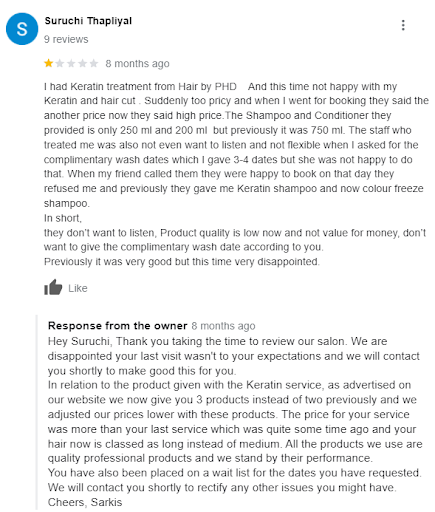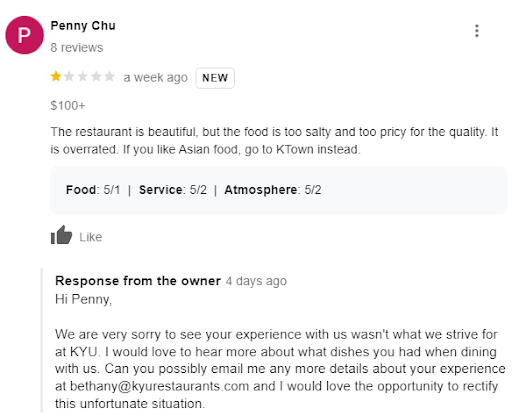Navigating online reviews can be a formidable challenge for local small businesses, yet mastering this aspect of digital presence is crucial for growth and customer trust. Understanding how to constructively engage with negative feedback is not just about damage control; it's a strategy for fostering positive customer relationships and enhancing your business reputation. This guide will provide detailed strategies, a comprehensive checklist for responding to negative reviews, examples, and customizable response templates specifically designed for local small businesses.
Understanding the Impact of Negative Reviews
Engaging with negative reviews is vital for several reasons:
- Influence on Purchasing Decisions: With the majority of consumers trusting online reviews as personal recommendations, a single negative review can significantly impact potential customers' decisions.
- Trust and Transparency: Acknowledging and responding to negative feedback demonstrates your commitment to customer satisfaction and continuous improvement.
- SEO Advantages: Active engagement with reviews, including negative ones, can boost your online visibility, attracting more customers to your business.
A Detailed 3-Step Checklist for Responding to Negative Reviews
1. Acknowledge the reviewer
- The first step in formulating a reply to a review is to sincerely listen to the customer and understand their concern. This requires a thorough examination of the review and, if possible, reviewing the customer's past interactions with the business for extra insight. For example, let's examine a case where a customer expressed dissatisfaction with their experience at a hair salon located in Columbus, Ohio.

Why it works?
- This review merits attention because it delves into a delicate and intricate issue, offering the business owner an opportunity to present their viewpoint. By carefully analyzing the review, the owner personalized their response by using the reviewer's name instead of a generic salutation, which enhances the response's impact.
- Moreover, the owner's public pledge to amend the situation and their skillful handling of the concern, including clarifying any confusion over pricing, demonstrates a clear commitment to transparency and prioritizing customer satisfaction.
2. Be Calm and professional
- A common theme observed in the negative review examples discussed in this blog is the practice of issuing apologies and recognizing criticisms. This strategy reflects the business owners' humility, empathy, and sincere dedication to ensuring customer contentment. Such an honest method not only aids in resolving the issue at hand but also builds trust and rapport, potentially transforming unhappy customers into supporters of the business. Consider the case of how an accounting firm in Sydney, Australia, addressed a negative encounter from a potential client.

Why it works?
- In this case, the owner's approach to the response was adeptly executed. The business owner steered clear of attributing fault to the customer or responding defensively about a possible error with the phone number.
- The owner instead offered reassurance about potential warranty options, indicated a strong resolve to address the concern, and invited the customer to get in touch through a provided phone number or email. This method effectively communicated the business's dedication to correcting the issue.
3. Take the conversation offline.
- Negative reviews serve as an important source of feedback for business owners, highlighting areas in need of enhancement. Absent this feedback, pinpointing weaknesses within the business might prove difficult.
- Yet, there are instances when reviewers leave only scant details, and negative comments on social media platforms could lead to protracted public discussions. Under these circumstances, it's essential to move the dialogue offline, working together with the customer to devise practical resolutions. A case in point is this critique of a restaurant located in New York City, New York, which exemplifies this scenario.

Why it works?
- Proposing a private conversation signals respect for the customer's issues and helps avoid further public flare-ups. In this case, the restaurant manager personally addressed the reviewer by name and politely encouraged her to reach out by email.
- This approach not only demonstrated an openness to learning about particular issues that might have been unknown to the restaurant before but also presented a chance to make amends. For potential customers reading the exchange, this proactive stance by the restaurant manager positively impacts their perception of the business.
Engaging on Key Platforms
For local small businesses, staying active on Google Reviews, Yelp, and Facebook Reviews is critical. These platforms are where your customers share their experiences and look for reassurance about the quality of your services or products.
Leveraging Reputation Management Software
To streamline the process of monitoring and responding to reviews across multiple platforms, consider investing in reputation management software. This tool can help ensure timely responses, maintain a consistent brand voice, and improve your overall online reputation.
Conclusion
Effectively managing online reviews, particularly negative ones, can significantly impact a local small business's success. By following the detailed checklist and utilizing the provided response templates, businesses can turn negative feedback into opportunities for improvement, customer trust, and enhanced digital presence.


